The Air-Based C4ISR Market is estimated to be valued at USD 3.5 billion in 2025 and is projected to reach USD 4.4 billion by 2035, registering a compound annual growth rate (CAGR) of 2.3% over the forecast period. A Breakpoint Analysis indicates a gradual but consistent increase in market value, with key transitions in growth patterns. Between 2025 and 2030, the market grows from USD 3.5 billion to USD 3.9 billion, contributing USD 0.4 billion in growth, reflecting a CAGR of 2.2%.
This early-stage growth is driven by ongoing investments in defense infrastructure, particularly in surveillance systems, communication technologies, and intelligence capabilities. The first breakpoint occurs around 2030, when the market reaches USD 3.9 billion, marking a shift toward a more stable, predictable growth phase. From 2030 to 2035, the market continues to expand at a slower rate, moving from USD 3.9 billion to USD 4.4 billion, contributing USD 0.5 billion in growth, with a slightly lower CAGR of 2.1%.
This phase exhibits a deceleration in growth, reflecting the maturation of the market as investments in air-based C4ISR systems become more standardized and competition intensifies. The Breakpoint Analysis indicates that while early growth is more robust, the market stabilizes in the latter half, with steady, incremental growth driven by technological advancements and ongoing demand from the military and defense sectors.
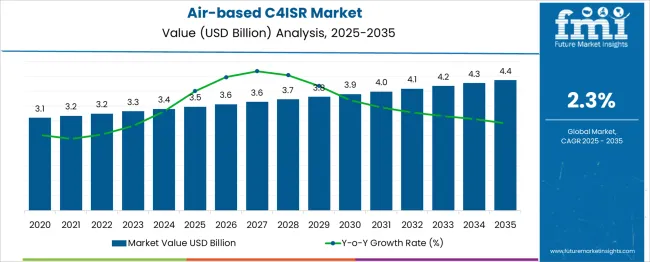
| Metric | Value |
|---|---|
| Air-Based C4ISR Market Estimated Value in (2025 E) | USD 3.5 billion |
| Air-Based C4ISR Market Forecast Value in (2035 F) | USD 4.4 billion |
| Forecast CAGR (2025 to 2035) | 2.3% |
The air-based C4ISR market is experiencing strong momentum, driven by the increasing demand for integrated airborne systems that support intelligence, surveillance, reconnaissance, and command operations. Strategic defense modernization programs across various nations are accelerating the deployment of manned and unmanned airborne platforms equipped with advanced C4ISR suites.
These systems have become vital for multi-domain awareness, high-speed data processing, and long-range operational reach in complex battle scenarios. The convergence of high-resolution sensors, AI-driven analytics, and satellite communications has enhanced the value of airborne platforms in coordinating missions across air, land, sea, and space.
Increased geopolitical tensions, evolving asymmetric threats, and the push for network-centric warfare have intensified investments in air-based C4ISR systems, especially those offering interoperability and real-time data sharing across command units. As governments prioritize rapid response and threat neutralization capabilities, the market is expected to witness continuous growth, particularly through joint ventures, defense contracts, and technological innovation in high-end reconnaissance aircraft and sensor payloads.
The air-based C4ISR market is segmented by platform, solution, application, end-use, and geographic regions. By platform, the air-based C4ISR market is divided into Manned aircraft and Unmanned aerial vehicles (UAVs). In terms of the solution, the air-based C4ISR market is classified into Hardware and Software Services. Based on the application of the air-based C4ISR market, it is segmented into Surveillance & reconnaissance, Command & control, Electronic warfare, Communication, and Others. The end-use of the air-based C4ISR market is segmented into Defense and Commercial. Regionally, the air-based C4ISR industry is classified into North America, Latin America, Western Europe, Eastern Europe, Balkan & Baltic Countries, Russia & Belarus, Central Asia, East Asia, South Asia & Pacific, and the Middle East & Africa.
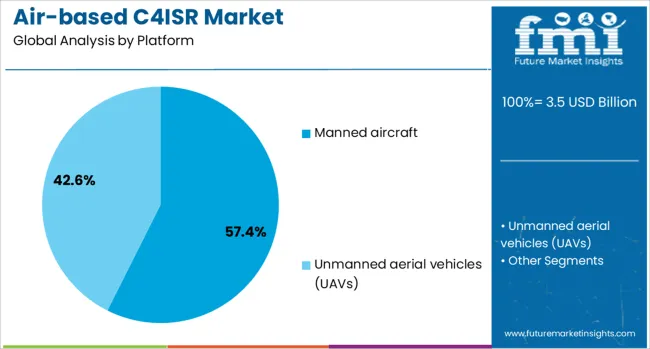
Manned aircraft are projected to hold 57.4% of the total revenue share in the air-based C4ISR market in 2025, making it the most dominant platform. This leadership is attributed to their high endurance, broader payload capacity, and the ability to execute complex missions under human control. Defense forces have continued to favor manned platforms for their flexibility in combining surveillance, reconnaissance, and command functions within a single mission cycle.
The segment has also benefited from technological upgrades in onboard radar, signal intelligence, and real-time data link systems that enhance mission accuracy and operational range. Manned aircraft enable immediate decision-making and situational adaptability, especially in contested airspaces or missions involving dynamic threat environments.
The integration of modular C4ISR components and lifecycle support programs has further sustained investment in these platforms. Their ability to accommodate multi-sensor payloads and act as persistent airborne command nodes has positioned manned aircraft as critical assets in both conventional and hybrid warfare operations.
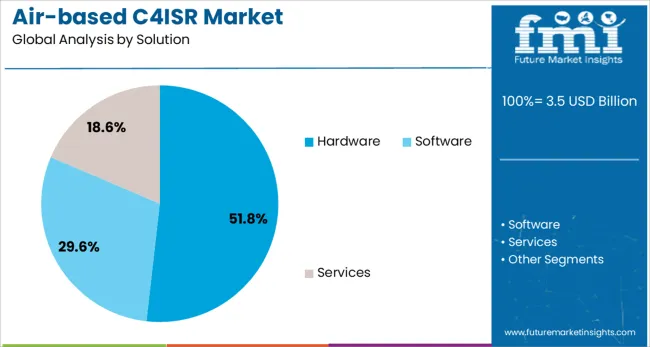
Hardware is expected to account for 51.8% of the total revenue share in the air-based C4ISR market in 2025, reflecting its foundational role in airborne intelligence systems. The increasing complexity and volume of onboard electronics, sensor arrays, and signal processing units essential for C4ISR missions is driving this dominance. Airborne platforms rely heavily on ruggedized and mission-specific hardware to support seamless operation in diverse environments and altitudes.
Investments in next-generation radar systems, high-resolution electro-optics, and secure communication interfaces have elevated the demand for hardware-centric solutions. The need for reliable and real-time data capture, processing, and transmission underpins hardware’s essential role across manned aircraft and unmanned platforms alike.
Additionally, military procurement contracts continue to prioritize upgradable and interoperable hardware systems to support evolving mission requirements. As the defense sector accelerates digital transformation, physical components that enable edge processing, sensor fusion, and electronic warfare protection are expected to remain at the forefront of procurement strategies.
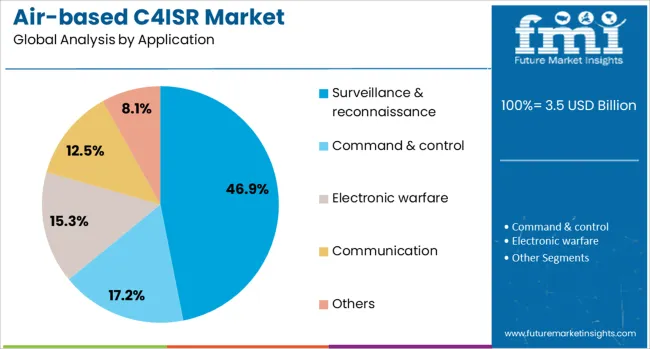
Surveillance and reconnaissance applications are projected to capture 46.9% of the total revenue share in the air-based C4ISR market by 2025, underscoring their critical role in modern warfare. The demand for persistent and wide-area surveillance capabilities has intensified due to the need for early threat detection, target tracking, and battlefield transparency. Airborne platforms outfitted with advanced imaging sensors, synthetic aperture radar, and signals intelligence equipment have become essential for gathering actionable intelligence across operational theaters.
The growing complexity of modern threats has led to increased reliance on high-altitude and long-endurance missions capable of operating in both contested and denied environments. Surveillance and reconnaissance systems integrated into air-based C4ISR platforms allow for real-time data transmission, rapid situational assessment, and mission flexibility, making them indispensable in defense planning.
The integration of artificial intelligence and autonomous processing has further enhanced the value of these applications by improving object identification accuracy and reducing analyst workload. As geopolitical instability continues, the segment is expected to remain a cornerstone of defense strategy.
Air-based C4ISR systems integrate command, control, communications, computers, intelligence, surveillance, and reconnaissance capabilities into airborne platforms, enhancing military operations. These systems are crucial for real-time intelligence gathering, secure communication, and situational awareness in defense and security operations. The market is supported by increasing demand for advanced surveillance, tactical communication systems, and the growing need for efficient decision-making in military operations. Providers offering systems with enhanced radar, real-time data analytics, and advanced sensor integration have gained preference. Airborne platforms optimized for rapid deployment, integration with existing military systems, and adaptability to various mission types continue to influence procurement decisions across defense sectors.
The air-based C4ISR market is primarily driven by the growing need for real-time intelligence and secure communication in defense operations. Airborne platforms equipped with advanced command, control, and surveillance systems enable military forces to collect timely data, ensure communication during operations, and make informed decisions in dynamic environments. These systems are critical in reconnaissance, tactical communication, and situational awareness. The increasing geopolitical tensions, alongside rising defense budgets, are pushing governments and defense organizations to invest in more sophisticated air-based C4ISR platforms that can provide enhanced surveillance, faster communication, and improved operational efficiency during military missions.
One of the key challenges in the air-based C4ISR market is the high cost of developing, deploying, and maintaining advanced systems. The technology involved in integrating radar, communications, and sensor technologies into airborne platforms is complex and requires significant investment. Additionally, ensuring that these systems work seamlessly together, especially across different aircraft and platforms, presents technical difficulties. The integration of air-based C4ISR systems with existing military infrastructure and the need for constant updates and maintenance can also be challenging, particularly for smaller defense budgets. Overcoming these costs and integration barriers is critical for the broader adoption of these systems.
The air-based C4ISR market offers substantial opportunities due to technological advancements and the ongoing modernization of military forces. Innovations in radar technology, satellite communication, and sensor systems are enhancing the capabilities of C4ISR platforms, making them more efficient and capable of handling complex tasks. The global trend toward increasing defense spending and modernizing military fleets provides a significant growth opportunity for C4ISR manufacturers. As more countries seek to enhance their defense capabilities, the demand for advanced air-based C4ISR systems is expected to continue rising, particularly in regions with escalating military tensions. This trend presents opportunities for manufacturers to develop innovative solutions that meet these evolving demands.
A significant trend in the air-based C4ISR market is the integration of artificial intelligence (AI) and autonomous systems into airborne platforms. AI is being increasingly used to analyze vast amounts of data in real time, providing actionable insights for military decision-makers. Autonomous drones and unmanned aerial vehicles (UAVs) equipped with C4ISR systems are also gaining traction as they can operate independently, reducing the need for human intervention and improving mission efficiency. These innovations are enhancing surveillance and reconnaissance capabilities while minimizing operational risks. The integration of these technologies into C4ISR systems is expected to transform how military forces gather intelligence and make strategic decisions.

| Country | CAGR |
|---|---|
| China | 3.1% |
| India | 2.9% |
| Germany | 2.6% |
| France | 2.4% |
| UK | 2.2% |
| USA | 2.0% |
| Brazil | 1.7% |
The air-based C4ISR market is projected to grow at a global CAGR of 2.3% from 2025 to 2035. China leads the market at 3.1%, followed by India at 2.9%, and France at 2.4%. The United Kingdom is expected to grow at 2.2%, while the United States is projected to grow at 2.0%. The rapid growth in China and India is primarily driven by the increasing focus on military modernization, defense technology advancements, and growing defense budgets. In OECD countries like France, the UK, and the USA, steady growth is supported by the need for enhancing defense capabilities, intelligence gathering, and air-based reconnaissance. The analysis spans 40+ countries, with the leading markets shown below.
China is projected to grow at a CAGR of 25.4% through 2035, driven by extensive integration of additive manufacturing technologies into UAV production. The defense sector leads demand for 3D printed drones to reduce production time and achieve lightweight designs with complex geometries. Domestic manufacturers are leveraging metal and composite-based 3D printing technologies for structural optimization. Research programs focus on hybrid manufacturing combining additive and subtractive processes for precision engineering. Growing investments in logistics and agricultural drone fleets further accelerate market adoption, while partnerships between drone startups and aerospace firms enhance innovation in endurance and payload capabilities.
India is projected to grow at a CAGR of 2.9% through 2035, driven by the country’s increasing defense budgets and the need to modernize its military aviation systems. As India enhances its air force capabilities, demand for air-based C4ISR systems is expected to rise significantly. The adoption of advanced surveillance and reconnaissance technologies for defense applications, alongside investments in next-generation military aircraft, is accelerating the growth of this market. Furthermore, India’s growing emphasis on border security and military intelligence is driving demand for enhanced air-based C4ISR solutions.
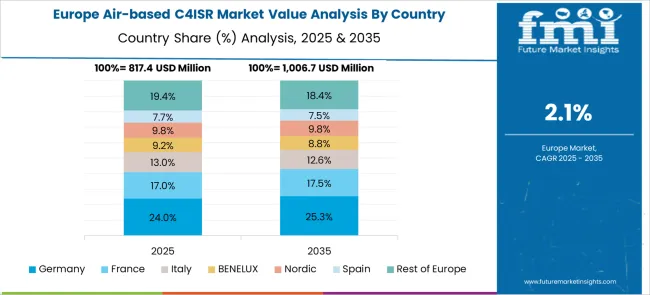
Germany is projected to grow at a CAGR of 2.4% through 2035, with demand for air-based C4ISR systems driven by the country’s increasing investments in defense technology and its focus on modernizing its air force. As Germany seeks to strengthen its air-defense and surveillance capabilities, demand for advanced C4ISR systems continues to rise. The adoption of high-performance air-based surveillance systems to monitor borders, track airspace, and gather military intelligence is contributing to the market growth. Additionally, Germany’s participation in NATO defense initiatives further drives the need for advanced C4ISR technologies.
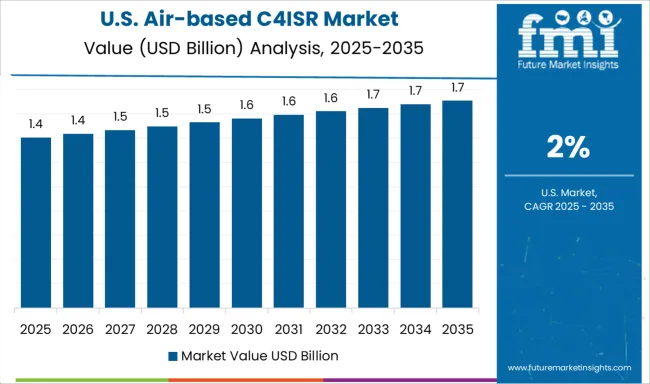
The United States is projected to grow at a CAGR of 2.0% through 2035, with the demand for air-based C4ISR systems driven by continuous advancements in military technology and intelligence operations. The USA military’s focus on maintaining technological superiority in air-based surveillance, reconnaissance, and intelligence gathering is crucial for the continued growth of this market. The increased deployment of UAVs and manned aircraft equipped with C4ISR capabilities to monitor airspace, gather intelligence, and provide real-time data is driving demand. Additionally, government defense initiatives aimed at boosting air-defense capabilities contribute to market growth.
The United Kingdom is projected to grow at a CAGR of 2.2% through 2035, with the market driven by investments in military intelligence and surveillance technologies. As the UK continues to modernize its air-defense systems and enhance its military capabilities, the demand for air-based C4ISR systems is expected to rise. The UK’s growing reliance on advanced surveillance technologies and unmanned systems for intelligence gathering and border security plays a major role in the adoption of these solutions. Government defense initiatives focused on enhancing the UK’s air force capabilities support the growth of this market.
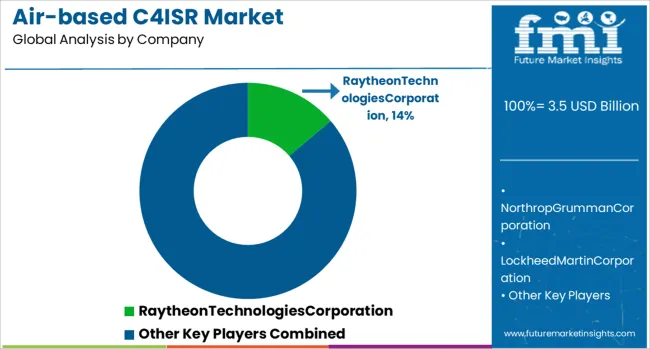
The air-based C4ISR (Command, Control, Communications, Computers, Intelligence, Surveillance, and Reconnaissance) market is driven by key defense contractors specializing in providing comprehensive and advanced solutions for military operations, focusing on intelligence gathering, surveillance, and communication capabilities. Raytheon Technologies Corporation is a market leader, offering cutting-edge air-based C4ISR systems that integrate radar, communication, and intelligence technologies for military aircraft. Northrop Grumman Corporation and Lockheed Martin Corporation are significant players, providing robust C4ISR solutions for air forces, with a focus on enhancing situational awareness, command and control, and real-time intelligence processing for defense operations.
BAE Systems PLC and L3 Harris Technologies Inc. provide advanced communication and surveillance technologies integrated into airborne systems, improving military capabilities through secure and efficient data transfer. Airbus offers military-grade C4ISR solutions, including satellite communications and intelligence systems, focusing on interoperability and advanced network capabilities for military aircraft. General Dynamics Corporation and Elbit Systems Ltd. specialize in integrated C4ISR solutions that enhance both tactical and strategic intelligence capabilities. Their systems are designed for seamless integration with military networks, ensuring timely and accurate information exchange. IAI Group and Thales focus on providing airborne intelligence systems, including synthetic aperture radar (SAR) and communication systems, to improve reconnaissance and surveillance. Leonardo S.p.A. and Saab AB provide integrated C4ISR solutions for defense applications, including secure communications and surveillance systems, enhancing military force coordination.
Rheinmetall AG, Cubic Corporation, and Systematic A/S also contribute to the market with innovative airborne C4ISR technologies that support real-time decision-making, intelligence-sharing, and secure communications for military forces. Competitive differentiation in this market is driven by technological innovation, system integration capabilities, data security, and the ability to provide comprehensive and customizable solutions for different defense applications. Barriers to entry include high R&D investment, compliance with military and aerospace regulations, and the need for strong industry partnerships. Strategic priorities include enhancing data processing capabilities, improving system interoperability, and expanding the adoption of AI-driven intelligence for future combat operations.
| Item | Value |
|---|---|
| Quantitative Units | USD 3.5 Billion |
| Platform | Manned aircraft and Unmanned aerial vehicles (UAVs) |
| Solution | Hardware, Software, and Services |
| Application | Surveillance & reconnaissance, Command & control, Electronic warfare, Communication, and Others |
| End-use | Defense and Commercial |
| Regions Covered | North America, Europe, Asia-Pacific, Latin America, Middle East & Africa |
| Country Covered | United States, Canada, Germany, France, United Kingdom, China, Japan, India, Brazil, South Africa |
| Key Companies Profiled | RaytheonTechnologiesCorporation, NorthropGrummanCorporation, LockheedMartinCorporation, BAESystemsPLC, L3HarrisTechnologiesInc., Airbus, GeneralDynamicsCorporation, ElbitSystemsLtd., IAIGroup, Thales, LeonardoS.p.A., SaabAB, RheinmetallAG, CubicCorporation, and SystematicA/S |
| Additional Attributes | Dollar sales by product type (C4ISR systems, communication systems, surveillance systems, radar systems) and end-use segments (military forces, defense contractors, governmental agencies). Demand dynamics are driven by increasing defense budgets, growing geopolitical tensions, and the rise in demand for advanced intelligence systems. Regional trends show strong growth in North America and Europe due to defense budgets and ongoing military modernization efforts, with expanding opportunities in Asia-Pacific as countries enhance their defense capabilities. |
The global air-based C4ISR market is estimated to be valued at USD 3.5 billion in 2025.
The market size for the air-based C4ISR market is projected to reach USD 4.4 billion by 2035.
The air-based C4ISR market is expected to grow at a 2.3% CAGR between 2025 and 2035.
The key product types in air-based C4ISR market are manned aircraft and unmanned aerial vehicles (uavs).
In terms of solution, hardware segment to command 51.8% share in the air-based C4ISR market in 2025.






Full Research Suite comprises of:
Market outlook & trends analysis
Interviews & case studies
Strategic recommendations
Vendor profiles & capabilities analysis
5-year forecasts
8 regions and 60+ country-level data splits
Market segment data splits
12 months of continuous data updates
DELIVERED AS:
PDF EXCEL ONLINE
C4ISR Market Size and Share Forecast Outlook 2025 to 2035
Space-based C4ISR Market Size and Share Forecast Outlook 2025 to 2035

Thank you!
You will receive an email from our Business Development Manager. Please be sure to check your SPAM/JUNK folder too.
Chat With
MaRIA